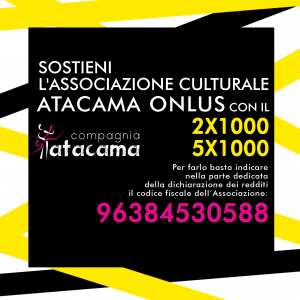Migrants is the new production by the Atacama Dance Company, which has been active for years in Italy and worldwide. This year, from June 23rd to 25th, on the stage of Tor Bella Monaca Theatre, the choreographers Patrizia Cavola and Ivan Truol have chosen to deal with a very frequently discussed topic of our times: migration and all social issues deriving from it.
As the choreographers say, they have explored “the concept of mobility, internal and external movement of individuals and groups, directions and migration flows, free and forced displacements, and invasions.”
The scene starts with a clear image: a blue light and a mass of people whose destinies are united by a continuous oscillating flow. They are the teens from the Dance High School of Rome, who were able to attend and take part in the creation of this performance during their school-work project. The four dancers of the company emerge from this scene with a choregraphic repeated sentence, expressing the heavy feeling of exhaustion after the trip and the need to set off for new roads.
The music stops and a dancer starts to whisper in an unrecognizable language. She is hopeless, nobody is able to understand her, everybody goes away from her because diversity, in human imagination, can create fear, unease and conflicts. She remains alone, walks and runs in place, while registered voices narrate the experiences, difficulties and daily life of a migrant.
From then on, the dancers’ bodies tell stories of encounters, opportunities and difficulties connected with the migration process. Individual stories are told, and the absolute protagonists of the scene are solitude, cold and shivering. But there are also stories of groups who, although pertaining to different cultures, can find a way to cohabitate, sharing affinities and diversities. For example, two girls meet between linear and curvilinear movements, while another girl, wrapped in a large silver towel, make us think of the discomfort of not having a place to sleep. Then, all together, they create a group and, little by little, they go away, stepping backwards and waving goodbye, with gestures of prayer and hope. Then the physical narration of occasions, events and dramas connected with the choice of mobility starts again.
In the last scene the Dance High School students come back again. They are all wearing colourful T-shirts and trousers. There seems to be a favourable environment for integration, for the search for stability that is necessary to accept oneself and to be accepted by a contemporary world that is full of exchanges and necessary displacements. Some of them proceed alone, but they hit an imaginary wall and are drawn back to their starting point. It looks like knowledge and adaptation is necessary for the whole community, so, finally, they all walk together on a path of discovery and integration.
All this is made explicit by stylistic research focused on physical theatre and willing to use all the expressive possibilities of the body. Lighting, directed by Danila Blasi, and music, synergistically created by the Epsilon Indi band and the dance company, contribute to the construction of delicate and visionary images. The richness of the Atacama company is really the solid and continuous research and the ability to stage a dance full of meaning, balancing stylistic trends and the attention to the communicative force of movement.
Delfina Stella


